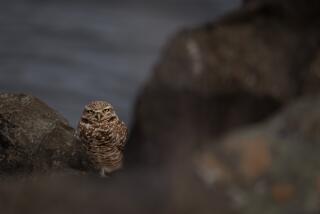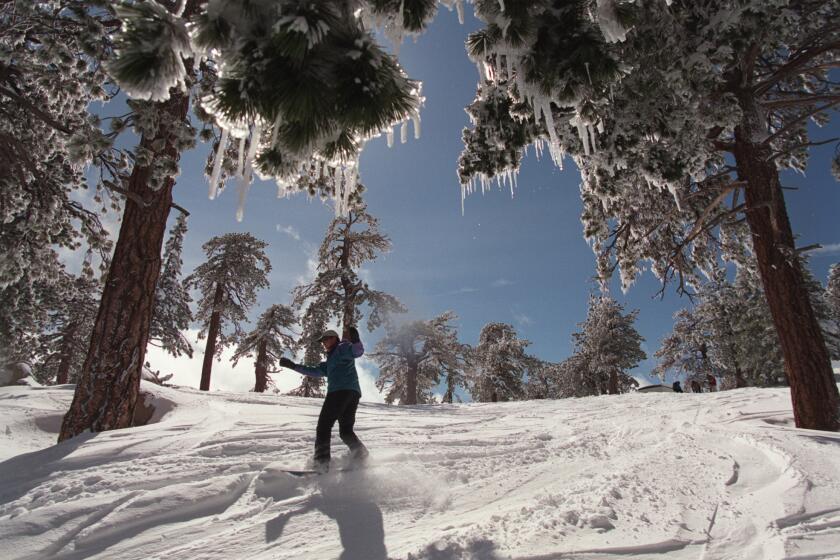Opinion: Birds are vanishing from North America. There’s a way to bring them back
Over three weeks starting Saturday, thousands of birders in the Western Hemisphere will take part in the annual, 119-year-old Audubon Christmas Bird Count. These tallies are conducted in prearranged circles within a seven-mile radius of a central point. At least 30 such circles exist in Southern California, and counts in each are held during a planned 24-hour period, rain or shine.
Bird lovers will no doubt list California scrub jays and acorn woodpeckers, but they may also catch glimpses of rarer travelers, such as a palm warbler or a thick-billed kingbird that stayed to spend the winter.
The Christmas count is usually a welcome ritual for bird lovers and naturalists. This year, however, it will be something of a grim reckoning. In September, a team of scientists published an ambitious study of more than 500 North American bird species, painstakingly comparing counts over time. The results made headlines and shocked even experts: There are almost 3 billion fewer birds in North America than there were 50 years ago. Among the vanishing are some species — meadowlarks and finches, for instance — that used to be abundant.
I have studied birds, taught about birds and written books about birds since the late 1970s in Southern California, and I’ve observed what those scientists documented: As we humans seize more and more wildlife habitat over time, the birds begin to disappear.
The Anthropocene — our era of human domination — has filled local lagoons with condo developments, polluted rivers and drained salt marshes. Freeways crisscross California’s coastal sagebrush bluffs, and as for grasslands, they have disappeared from the foothills. Fire, often caused by human negligence, has ravaged the remaining pockets of coniferous forest in our mountains.
Where a bird lives, forages, nests and raises young is its home range, its habitat. When that habitat is destroyed or fractured, a species will fail to reproduce. It will leave or perish.
And yet the urgent problem of habitat loss can be remedied.
At the San Joaquin Marsh and Wildlife Sanctuary in Orange County, a former duck club is now a restored wetland within a stone’s throw of high-rises and shopping malls. A rare shorebird turned up there in August — a common ringed plover. This tiny bird with a thick black breast band nests in Greenland and on Canadian Arctic islands; it usually heads to the west coast of Africa rather than landing in Orange County.
In the path of jumbo jets taking off from Los Angeles International Airport, where a development was razed to make way for runways, volunteers have restored sand dunes and coastal sage scrub. Last winter, 10 burrowing owls — a California “species of special concern” — were counted there, in a spot they haven’t frequented in decades. The owls, along with the California gnatcatcher and the El Segundo blue butterfly, don’t seem to mind the roar of the jet engines.
In my home territory, Santa Barbara, there is a particularly spectacular example of what is possible. Now part of the UC Santa Barbara campus, a former golf course north of the university built on marsh upland has been carefully restored. More than 10 years ago, the Trust for Public Land purchased the then-decrepit Ocean Meadows course, which was handed over to the Cheadle Center for Biodiversity and Ecological Restoration at the university. Fundraising went into high gear, partnerships were developed, scientists and planners weighed in, and so did the site’s neighboring homeowners.
The chances for restoration were rich and varied: salt marsh, perennial grassland mesa and peripheral uplands closer to the condo developments. Bulldozers widened a former creek bed and the restoration plan reconstituted the natural watershed. University students, citizens and schoolchildren gathered seed from native plants, nurtured the seedlings and then replanted the site. The 136-acre North Campus Open Space opened in 2018.
Years ago, I and fellow birders used to stand wistfully at the margins of the old private golf course, looking through our binoculars to see what species remained after the marsh was disturbed. Last month, I strolled along a level path, surrounded by watery inlets and tall reeds, watching ducks and shorebirds feed. On a distant hillside, a burrowing owl had already claimed one of the “hibernacula,” a manmade burrow. Western meadowlarks were visiting the newly planted grassland portion. One birder, posting on the North Campus Open Space eBird list, tallied 46 species in just over two hours earlier this month.
The North Campus restoration is the Anthropocene at its best: humans mitigating our own destructive impact in grand style. But even a more minimal effort — a pocket park in an urban center, a small plot of restored shoreline plants — can yield a big payoff for wildlife, not to mention people. And of course, the best solution for the problem of disappearing birds is not to destroy their precious habitat in the first place.
As development squeezes out nature, we are all the losers. Save the birds and you are saving our natural world. It’s not too late.
Joan Easton Lentz’s latest book is “A Naturalist’s Guide to the Santa Barbara Region.”
More to Read
A cure for the common opinion
Get thought-provoking perspectives with our weekly newsletter.
You may occasionally receive promotional content from the Los Angeles Times.






